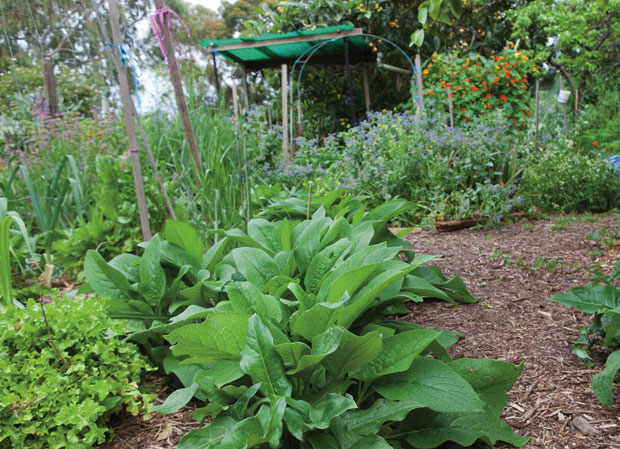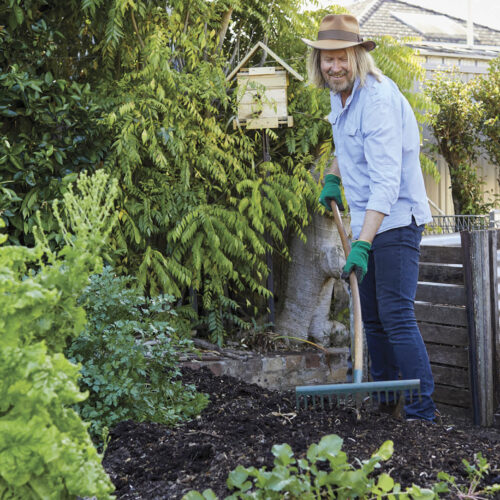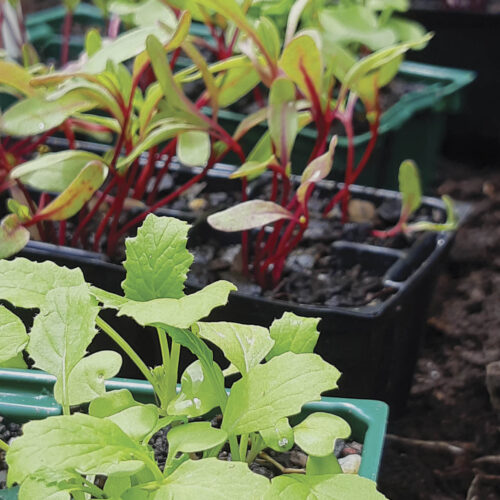Design for Climate Change
2012-01-30T07:29:16+11:00
In an edited extract from his comprehensive and inspiring book 'The New Organic Gardener', TIM MARSHALL says building the soil and keeping plants cool are key gardening strategies to counter climate change.
The climate is getting warmer and climate scientists predict that many parts of Australia will become drier. The most commonly agreed prediction is for an escalation of storms and an increase in the intensity of rainfall, even possibly in areas where the total rainfall will decline. Warnings of climate change are too consistent to ignore, so garden planning must take them into account.
Understanding climate and the effect it has upon plants will help to reduce failures caused by bad species selection or neglecting to provide the right location to exploit the local microclimate.
Organic practices can both ameliorate against climate change and help us to adapt to it. A key feature of organic gardening is the emphasis on increasing the soil’s organic matter, which is principally made up of carbon. The only cheap and easy way to remove carbon from the atmosphere is to grow green plants.
However, green plants do not take carbon out of the atmosphere for a long time. Even trees will usually not live for more than about 100 years, and if they do, their growth is so slow that they will not be taking much additional carbon from the atmosphere.
However, by using appropriate soil biology, we can convert plant carbon into soil carbon. Humus, the end product of the breakdown of organic matter, is very long-lived and therefore an excellent store of carbon. The average age of a piece of humus in Australian soil is probably between 1000 and 2000 years.
Even in a forest, it is likely that more carbon will be found under the ground, in the roots, soil, animals and the organic matter, than in the above-ground biota. We can deepen and strengthen soils much faster with best-practice organic methods than by any other means.
Apart from leading to high levels of carbon storage in the soil, improved organic matter content and continuous soil cover with plants or mulch keeps the soil structure in good condition. This helps the soil to cope better with more intense rainfall, which is predicted for many parts of Australia as the climate changes, because it can absorb moisture faster, thereby reducing run-off and erosion.
Organic strategies that build and preserve the soil’s organic matter include the following:
- Recycling of all organic matter by digging-in, mulching and composting;
- Green manures, cover crops, companion planting and polyculture to maintain soil cover for as long as possible;
- Emphasis upon total biology, including the fungal component;
- Careful use of tillage, including use of non-inversion techniques, and using deeper tillage as an opportunity to incorporate organic matter and soil amendments;
- Absence of water-soluble fertilisers – particularly synthetic nitrogen – and herbicides, which harm soil biology and reduce organic matter preservation.
Warmer, drier climates
As climate change is expected to cause longer drier spells, organic methods will help the soil to preserve water for the following reasons:
- Organic matter and humus improve infiltration rates so that water moves into the soil more easily;
- Organic matter and humus can hold a lot of water;
- Roots can explore open, well-structured soils more completely and develop deep and extensive root systems, and therefore become more water self-sufficient; and
- Organic soils sponsor symbiotic bacteria and fungi that help plants find nutrients and reduce their reliance on obtaining nutrients from the soil solution (soil water).
But despite the benefits that organic methods may bring, water availability may be reduced by long dry spells in the future and water prices will rise. This will impact upon the type of gardens we grow in the future, and the way we manage them. The chief adjustments to reduced water use will be improved application methods and timing, use of mulch, and the selection of local indigenous and hardy introduced plants. Despite these adjustments, many gardeners will still want to dedicate part of the garden to their favourite, more water-demanding plants, and to food plants. Climate change is not doomsday for gardeners, but it is a wake-up call to understand how water, soil and plants work.
Cool your plants
Cool plants use less water. During hot spells, plants should be kept as cool as possible. When plants get hot they have to transpire water through their leaves. This internal air-conditioning system is their only way of keeping cool. If plants can’t keep up with the transpiration required to stay cool, their leaves will wilt. Some plants can handle significant wilting and recover in the cool of the afternoon or evening, but some species do not recover well.
Shelter from wind reduces transpiration because in still air the atmosphere immediately around the leaf becomes humidified with the vapour emerging from the open stomata (pores) on the underside of the leaf; eventually the atmosphere can’t absorb any more vapour droplets from the plant, and thereby transpiration is slowed down. In contrast, moving air blows the moisture away, causing the plant to continue to transpire.
To help plants keep cool during hot spells, position them so they receive shade and wind shelter from taller plants, or construct artificial structures. Physical barriers consisting of 50 per cent white shade-cloth will protect valuable garden plants and vegetables by reducing sunburn to the leaves and fruit and lowering the temperature. Physical screens can be permanent or temporary.
Spray-on sunscreens for plants are available but most contain polymers that are not considered organic. Organic sunscreen products have been trialled on certified organic farms and may be available for home gardeners in the future. A fine suspension of clay sprayed on the leaves does a similar job. Clay powder with a uniform, small particle size can be purchased from mineral, pottery/ceramic or alternative health and beauty suppliers.
Kelp extract provides bio-stimulants that help plants to moderate water loss. By providing the right soil conditions, such as breaking up hardpan (a layer of hard subsoil or clay), and using deep but infrequent watering, plants will send down deep roots which will build up the soil profile and add organic matter at depth, thereby increasing water storage in the soil and the ability of roots to find water.
Building biodiversity
As one of the key principles of organic gardening is diversity, organic gardeners should design their gardens with a wide variety of plants in mind. Biodiversity above and below ground is a key factor in maximising plant cover and will therefore assist in maximising carbon storage in the soil.
To achieve the greatest biodiversity, include some indigenous plants (that is, plants indigenous to your local area) and a continuous sequence of flowering plants. If there are no flowers in your garden, a wide range of useful birds and insects will not spend much time there, and if there is no water, frogs and lizards will only pass through.
It is also useful to provide a range of different habitats, particularly a source of water, and a variety of planting layers (trees, shrubs and under-storey plants). Garden plants should enhance local indigenous biodiversity rather than detract from it. Many garden plants, especially those that produce flowers and fruit, will provide food for useful or entertaining native animals, such as the honeyeaters that visit the japonica outside my kitchen window. But remember to select plants that will not encroach upon local bushland.
Each planting layer provides different opportunities for insects, birds and animals to shelter or hunt. Examples are:
- Trees attract stick insects and praying mantis, as well as larger animals such as owls and kookaburras that will perch on the tree branches looking for rodents, snakes or
- other prey.
- Shrubs provide many useful small insectivorous birds with a place to roost and to retreat to when threatened. These birds will provide a lot of pest control if they can find shelter.
- Flowering plants will encourage some of the most colourful and entertaining birds to visit in search of nectar, berries and seeds. Hunting wasps feed on nectar and pollen, and need a continuous source of open flowers throughout the year, otherwise they will go elsewhere.
- My local thrush is endangered, but is an occasional visitor to my garden because I have a combination of deep shade and deep mulch, exactly the conditions it prefers for feeding.
- Lizards will visit if there is some ground-level water, but birds will hesitate to land on the ground and prefer an elevated bird bath.






